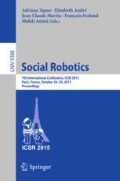Abstract
Joint attention is an early-developing social-communicative skill in which two people (usually a young child and an adult) share attention with regards to an interesting object or event, by means of gestures and gaze, and its presence is a key element in evaluating the therapy in the case of autism spectrum disorders. In this work, a novel automatic system able to detect joint attention by using completely non-intrusive depth camera installed on the room ceiling is presented. In particular, in a scenario where a humanoid-robot, a therapist (or a parent) and a child are interacting, the system can detect the social interaction between them. Specifically, a depth camera mounted on the top of a room is employed to detect, first of all, the arising event to be monitored (performed by an humanoid robot) and, subsequently, to detect the eventual joint attention mechanism analyzing the orientation of the head. The system operates in real-time, providing to the therapist a completely non-intrusive instrument to help him to evaluate the quality and the precise modalities of this predominant feature during the therapy session.
Preview
Unable to display preview. Download preview PDF.
References
Anzalone, S.M., Tilmont, E., Boucenna, S., Xavier, J., Jouen, A.L., Bodeau, N., Maharatna, K., Chetouani, M., Cohen, D., Group, M.S., et al.: How children with autism spectrum disorder behave and explore the 4-dimensional (spatial 3d+ time) environment during a joint attention induction task with a robot. Research in Autism Spectrum Disorders 8(7), 814–826 (2014)
Canny, J.: A computational approach to edge detection. IEEE Trans. Pattern Anal. Mach. Intell. 8(6), 679–698 (1986)
Carpenter, M., Liebal, K.: Joint attention, communication, and knowing together in infancy (2011)
Diehl, J.J., Schmitt, L.M., Villano, M., Crowell, C.R.: The clinical use of robots for individuals with autism spectrum disorders: A critical review. Research in Autism Spectrum Disorders 6(1), 249–262 (2012)
Emery, N.: The eyes have it: the neuroethology, function and evolution of social gaze. Neuroscience & Biobehavioral Reviews 24(6), 581–604 (2000)
Feil-Seifer, D., Matarić, M.J.: Toward socially assistive robotics for augmenting interventions for children with autism spectrum disorders. In: Khatib, O., Kumar, V., Pappas, G.J. (eds.) Experimental Robotics: The Eleventh International Symposium. Springer Tracts in Advanced Robotics, vol. 54, pp. 201–210. Springer, Heidelberg (2009)
Gulsrud, A.C., Hellemann, G.S., Freeman, S.F., Kasari, C.: Two to ten years: Developmental trajectories of joint attention in children with asd who received targeted social communication interventions. Autism Research 7(2), 207–215 (2014)
Imai, M., Ono, T., Ishiguro, H.: Physical relation and expression: Joint attention for human-robot interaction. IEEE Transactions on Industrial Electronics 50(4), 636–643 (2003)
Jones, E.A., Carr, E.G.: Joint attention in children with autism theory and intervention. Focus on Autism and Other Developmental Disabilities 19(1), 13–26 (2004)
Khoramshahi, M., Shukla, A., Billard, A.: From joint-attention to joint-action: effects of gaze on human following motion. In: 6th Joint Action Meeting (2015)
Li, A.X., Florendo, M., Miller, L.E., Ishiguro, H., Saygin, A.P.: Robot form and motion influences social attention. In: Proceedings of the Tenth Annual ACM/IEEE International Conference on Human-Robot Interaction, pp. 43–50. ACM (2015)
Moore, C., Dunham, P.: Joint attention: Its origins and role in development. Psychology Press (2014)
Prasad, D.K., Leung, M.K.: Methods for ellipse detection from edge maps of real images. In: Machine Vision - Applications and Systems, pp. 135–162. InTech (2012)
Robins, B., Dickerson, P., Stribling, P., Dautenhahn, K.: Robot-mediated joint attention in children with autism: A case study in robot-human interaction. Interaction Studies 5(2), 161–198 (2004)
Rogers, S.J., Dawson, G.: Early Start Denver Model curriculum checklist for young children with Autism. Guilford Press (2009)
Scaife, M., Bruner, J.S.: The capacity for joint visual attention in the infant. Nature (1975)
Scassellati, B., Admoni, H., Mataric, M.: Robots for use in autism research. Annual Review of Biomedical Engineering 14, 275–294 (2012)
Staudte, M., Crocker, M.W.: Investigating joint attention mechanisms through spoken human-robot interaction. Cognition 120(2), 268–291 (2011)
Stauffer, C., Grimson, W.: Adaptive background mixture models for real-timetracking. In: IEEE Int. Conf. on. Comp. Vision and Patt. Recognition. vol. 2, p. 252 (1999)
Warreyn, P., Paelt, S., Roeyers, H.: Social-communicative abilities as treatment goals for preschool children with autism spectrum disorder: the importance of imitation, joint attention, and play. Developmental Medicine & Child Neurology 56(8), 712–716 (2014)
Warreyn, P., Roeyers, H.: See what i see, do as i do: Promoting joint attention and imitation in preschoolers with autism spectrum disorder. Autism 18(6), 658–671 (2014)
Zhao, X., Cusimano, C., Malle, B.F.: Do people spontaneously take a robot?s visual perspective? In: Proc. of the ACM/IEEE Intern. Conf. on Human-Robot Interaction Extended Abstracts, pp. 133–134. ACM (2015)
Zivkovic, Z.: Improved adaptive gaussian mixture model for background subtraction. In: Proc. of the IEEE Intern. Conf. on Patt. Recogn. vol. 2, pp. 28–31 (2004)
Author information
Authors and Affiliations
Corresponding author
Editor information
Editors and Affiliations
Rights and permissions
Copyright information
© 2015 Springer International Publishing Switzerland
About this paper
Cite this paper
Cazzato, D., Mazzeo, P.L., Spagnolo, P., Distante, C. (2015). Automatic Joint Attention Detection During Interaction with a Humanoid Robot. In: Tapus, A., André, E., Martin, JC., Ferland, F., Ammi, M. (eds) Social Robotics. ICSR 2015. Lecture Notes in Computer Science(), vol 9388. Springer, Cham. https://doi.org/10.1007/978-3-319-25554-5_13
Download citation
DOI: https://doi.org/10.1007/978-3-319-25554-5_13
Published:
Publisher Name: Springer, Cham
Print ISBN: 978-3-319-25553-8
Online ISBN: 978-3-319-25554-5
eBook Packages: Computer ScienceComputer Science (R0)

